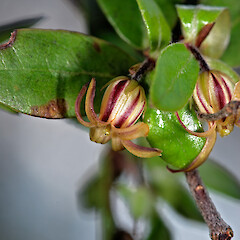Pittosporum pimeleoides subsp. majus
Synonyms
Pittosporum michiei Allan; Pittosporum pimeleoides var. major Cheeseman, Pittosporum pimeleoides subsp. maius (Cheeseman) R.C.Cooper orthographic variant,
Family
Pittosporaceae
Flora category
Vascular – Native
Endemic taxon
Yes
Endemic genus
No
Endemic family
No
Structural class
Trees & Shrubs - Dicotyledons
Chromosome number
2n = 24
Current conservation status
The conservation status of all known New Zealand vascular plant taxa at the rank of species and below were reassessed in 2017 using the New Zealand Threat Classification System (NZTCS) – more information about this can be found on the NZTCS website. This report includes a statistical summary and brief notes on changes since 2012 and replaces all previous NZTCS lists for vascular plants.
Please note, threat classifications are often suggested by authors when publications fall between NZTCS assessment periods – an interim threat classification status has not been assessed by the NZTCS panel.
- Conservation status of New Zealand indigenous vascular plants, 2017 . 2018. Peter J. de Lange, Jeremy R. Rolfe, John W. Barkla, Shannel P. Courtney, Paul D. Champion, Leon R. Perrie, Sarah M. Beadel, Kerry A. Ford, Ilse Breitwieser, Ines Schönberger, Rowan Hindmarsh-Walls, Peter B. Heenan and Kate Ladley. Department of Conservation. Source: NZTCS and licensed by DOC for reuse under the Creative Commons Attribution 4.0 International licence.
2017 | Threatened – Nationally Endangered | Qualifiers: OL
Previous conservation statuses
2012 | At Risk – Naturally Uncommon | Qualifiers: OL, Sp
2009 | At Risk – Naturally Uncommon | Qualifiers: CD, ST, OL
2004 | Range Restricted
Brief description
Rare much-branched low-growing shrub with whorls of rounded leaves and red-striped yellow flowers and 6–12mm long capsules inhabiting the northern tip of the North Island. Leaves 9–30mm long by 4.5–13mm wide. Fruit splitting into two to show the black sticky seeds in orange pith.
Distribution
Endemic. New Zealand: North Island (Hikurua / de Surville Cliffs and adjacent plateau).
Habitat
An ultramafic endemic naturally confined to the 120-ha exposure of serpentinite at the North Cape (Otou) – Hikurua / de Surville Cliffs, Te Paki. In that habitat it is very common in low scrub and at the bases of talus slopes on the cliffs proper. It is also present on the plateau, where it is less common, presumably because of the once frequent fires that swept that area.
Detailed description
Much branched, gynodioecious, decumbent, prostrate, trailing and spreading gynodioecious shrub 0.1–0.6 m tall; confined to ultramafic substrates. Usually multi-trunked from the ground, branches and branchlets slender, wiry, pliant, spreading, arching and layering on contact with soil; coloured grey-brown; branchlets similar but at first densely clad in greyish-white to brown tomentum becoming glabrate with age. Leaves alternate, in distinct whorls (semi-verticillate). Petioles up to 5 mm long, hairy. Lamina 9–30 × 4.5–5–(13), pale green, red-green or dark green above, paler beneath, broadly elliptic, apex acuminate or obtuse, base attenuate, margins entire or finely crenulate, surfaces sparsely hairy with ciliolate margins when young, becoming glabrate, coriaceous. Flowers usually terminal, 4–12 fascicled. Pedicels 2–9 mm, filiform, puberulent, accrescent in fruit, subtended by a whorl of leaves and several 2–3 mm long, caducous, glabrous, ciliolate bud scales. Sepals 4.5–5 × 0.5–1 mm, linear, acuminate, glabrous. Petals 11–12 mm, yellow with a central or margin red stripe, rarely completely yellow or cream, linear, acuminate, fused in a tube to about half way, then spreading and reflexed. Stamens 2.5–6.5 mm, anthers 0.5–2 mm. Ovary 1–2 × 1–1.5 mm, villous, style 1.5–3.5 mm. Stigma capitate, 2-lobed or truncate. Capsules 2-valved, 6–12 × 4–6 mm, green at first brown when mature, ovoid, acuminate, coriaceous, initially covered in long grey hairs otherwise glabrate. Mucilage yellow to dark orange. Seeds 5–18, glossy black, of irregular shape.
Similar taxa
Pittosporum pimeleoides subsp. pimeleoides, which is a highly variable plant with respect to leaf length and width. In its typical form it has narrowly lanceolate to linear-lanceolate leaves, an erect growth habit, and smaller flowers. However some forms may have broader leaves and a more spreading, semi-decumbent habit. These forms can be locally common in parts of eastern Northland, they differ from subsp. majus by their erect to semi-erect sprawling stems, somewhat longer leaves, and smaller flowers.
Flowering
(May)–July–September
Flower colours
Red/Pink, Yellow
Fruiting
Present throughout the year
Propagation technique
Easily grown from seed which germinates within 3–6 months of sowing. Also strikes well from semi-hardwood cuttings. Established plants can be easily layered. Despite its natural restriction to ultramafic rocks it grows well in any free draining soil. Prefers full sun. Should not be planted near P. pimeleoides subsp. pimeleoides because of the risk of hybridisation.
Threats
Pittosporum pimeleoides var. majus naturally occupies a small area at North Cape so any population decline is of concern. Although P. pimeleoides var. majus is difficult to survey because of its trailing growth habit, a decline in the population has been observed. Possums are a major threat and scale insects are also a problem.
Etymology
pittosporum: Pitch seed
pimeleoides: Like a pimelea
Taxonomic Notes
Records of this subspecies occurring further south at the Whangaroa Harbour refer to a wide-leaved semi-erect, sometimes sprawling form of P. pimeleoides subsp. pimeleoides. This variant, locally common in some places around that harbour tends to form an erect bush with occasional sprawling branches in cultivation. It has flower dimensions typical of subsp. pimeleoides (which is a very variable entity).
Attribution
Fact sheet prepared for NZPCN by P.J. de Lange 30 August 2006. Description adapted from Cooper (1956).
References and further reading
Cooper RC. 1956. The Australian and New Zealand species of Pittosporum. Annals of the Missouri Botanical Garden 43: 87–188. https://www.biodiversitylibrary.org/page/26841965#page/95/mode/1up
NZPCN Fact Sheet citation
Please cite as: de Lange, P.J. (Year at time of access): Pittosporum pimeleoides subsp. majus Fact Sheet (content continuously updated). New Zealand Plant Conservation Network. https://www.nzpcn.org.nz/flora/species/pittosporum-pimeleoides-subsp-majus/ (Date website was queried)











